Technologies To Command Pain
Day-to-day life can be a battle when you’ve got chronic pain. Thus researchers are searching for alternative methods of pain relief.
Below are 5 top technologies to command pain :
Company : Omron Healthcare
Applications : Acute joint and muscle pain
About this technology : This over-the-counter device combines heat with transcutaneous electrical nerve stimulation (TENS) to provide pain relief for acute joint and muscle pain. TENS relieves pain by sending electrical pulses across the skin and along nerves, thus preventing pain signals from reaching the brain. In addition, electrical stimulation can also lead to the release endorphins, which provide natural pain relief.
Efficacy : The HEAT Pain Pro™ TENS Device has 27 combinations of heat and TENS, 20 levels of intensity, and has pre-set options for different locations of pain, including the lower back, arms, legs, feet, shoulders, and joints. It has a rechargeable battery, gel pads that can be used 30 times before replacement, and fits in the palm of the hand. It is available through OmronHealthcare.com, Amazon, CVS, and Walgreens without a prescription. The suggested retail price is $89.99.
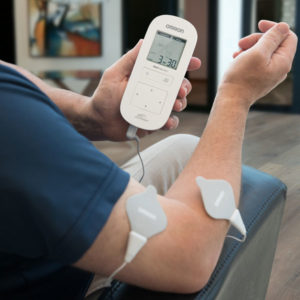
Companies : St. Jude Medical, Inc, Haylard Health, Inc, Boston Scientific Corporation, Diros Technology, Inc
Applications : Chronic pain conditions, geriatric pain
About this technology : Radiofrequency (RF) therapy uses the heat generated from a medium frequency alternating current (350-500 kHz) to denervate tissues that are part of the peripheral nervous system. When performed with a catheter, it is called radiofrequency catheter ablation.
Efficacy : Radiofrequency ablation is a minimally invasive alternative to surgery. Due to an increase in chronic pain conditions, as well as the rising global geriatric population, the demand for radiofrequency ablation for pain is expected to increase, according to a report from Transparency Market Research. Benefits of this technology include reductions in surgery-related complications, adverse effects, recovery time. In addition, the device is easily available and cost-effective.
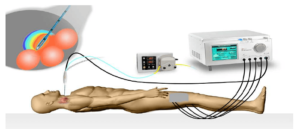
Company : BioElectronics Corporation
Applications : Chronic pain from osteoarthritis, rheumatoid arthritis, shingles, neuropathy, sports injuries, and fibromyalgia, and post-surgical pain
About this technology : Actipatch is a non-invasive, electroceutical device which uses electromagnetic fields to modulate efferent nerve activity, dampening the brain’s perception of pain. The device pulses signals at 1 kHz into the painful tissue, preventing the brain from adapting to the stimulus.
Efficacy : Completed clinical trials indicate device efficacy in reducing pain (including musculoskeletal, postoperative, and menstrual pain), and restoring normal function, such as allowing people to get a full nights’ sleep, in many patients. It is currently the only neuromodulation electroceutical device available over-the-counter for managing chronic pain. It is safe to use with metal implants, pacemakers, and defibrillators, as well as in diabetics, arthritics, and the elderly. It is not for use in pregnant women. It allows for 720 hours of use and has an on/off switch.
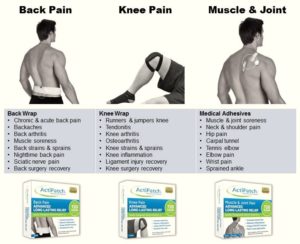
- BurstDR Stimulation
Company : St. Jude Medical, Inc
Applications : Chronic pain
About this technology : This new physician-designed form of spinal cord stimulation (SCS) provides “bursts” of pulses that mimic natural nerve impulse patterns in the body, unlike other types of SCS. This burst mode was developed to prevent the body from becoming accustomed to SCS therapy and developing a tolerance, a common occurrence in SCS.
Efficacy: The results revealed that 69.4% of patients preferred the burst stimulation for treating chronic pain, and 91% also reported a decrease in paresthesia, compared with traditional SCS. Allen Burton, medical director of neuromodulation and vice president of medical affairs at Saint Jude, also noted that the 21% who preferred traditional SCS could also be accommodated; the SCS devices are capable of both and will have “built-in patient choice.” Now that the US FDA has approved the therapy, patients who receive new implants of the St. Jude Medical Proclaim™ Elite and Prodigy MRI™ spinal cord stimulation systems will be able to access the burst therapy immediately. Those who already have the upgradable Protégé and Proclaim SCS systems will be able to upgrade and access the burst therapy without surgery.
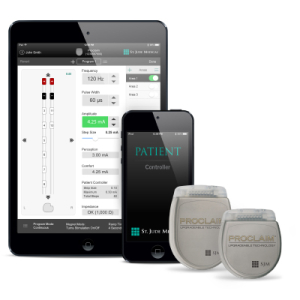
Company : DeepStream VR
Applications : Chronic pain
About this technology : This is one of the VR worlds immerse patients into a full-body sensory experience. They differ from movies or games visualized on a screen due to their level of interaction and immersion that command a higher level of brain attention. In Cool!, patients wear a VR headset and explore a 360 degree immersive world, using a mouse to toss fish and magic orbs to playful otters, all this, in a beautiful landscape.
Efficacy : Ted Jones, PhD, from the Behavioral Medicine Institute in Knoxville, Tennessee, and colleagues conducted an independent study to determine whether DeepStream VR’s pain relief game “Cool!” would provide pain relief to patients with neuropathic pain. The first study examined a single, 5-minute treatment session in 30 patients with neuropathic pain. Thereby, the Researchers found that pain decreased an average of 60% during the session and 33% after the session, and the relief lasted from 2 to 48 hours after completion of the game. The second study is examining multiple 20-minute treatment sessions in 7 patients, and is still ongoing.
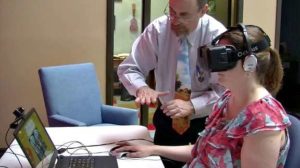
-Shreesha Balan
These were some of the technologies to command pain, we hope you liked our article.
For more technology related articles, click here



3 Comments
Lorenzo Gutierrez · September 17, 2019 at 4:09 am
Solid list thanks for sharing. My favorite is the heat pain pro.
John Gatesby · January 29, 2020 at 11:26 am
These tools look interesting especially TENS technology has been used previously with some success to alleviate the pain. If these tools work then a new branch of alternative treatment for pain will emerge, which will not have the usual side effects of medication
Medit · February 26, 2020 at 5:06 pm
Thanks for sharing this list!